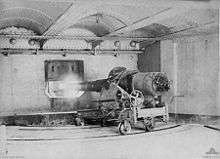BL 6 inch gun Mk V
| Armstrong BL 6-inch 30 calibre gun | |
|---|---|
|
Disappearing gun at Fort Chulachomklao, Thailand | |
| Type | Coast defence gun |
| Place of origin | United Kingdom |
| Service history | |
| In service | 1884 - 1945[1] |
| Used by |
United Kingdom Australian Colonies New Zealand Siam |
| Production history | |
| Designer | Elswick Ordnance Company (EOC) |
| Manufacturer | EOC |
| Unit cost | £3,400[2] |
| Specifications | |
| Weight | 5 tons barrel & breech[3] |
| Barrel length |
183.5 inches (4,661 mm) bore (30.58 calibres);[4] 192 inches (4,877 mm) bore and chamber (32 calibres)[5] |
|
| |
| Shell | 100 pounds (45.36 kg)[4] |
| Calibre | 6-inch (152.4 mm) |
| Breech | 3 motion interrupted screw. Elswick cup obturation |
| Muzzle velocity | 1,890 feet per second (576 m/s)[6] |
| Maximum firing range | 8,000 yards (7,300 m)[7] |
The BL 6 inch gun Mk V [note 1] was an early Elswick Ordnance Company breech-loading naval gun originally designed to use the old gunpowder propellants. They were used for coast defence around the British Empire.
Description and service

This was an Elswick Ordnance export design, completely different from and longer (30-calibres, 183.5 inch bore) than the contemporary 26-calibres British naval service 6-inch Mk III, IV and VI guns designed by the Royal Gun Factory, although it fired the same 100-pound projectiles. The gun was of a complex all-steel built-up construction, of a steel A-tube surrounded by multiple steel hoops, breech-piece and jacket.
Several were acquired by the British government for coast defence in the UK and were given the designation 6-inch gun Mark V. The breech fittings and firing mechanism were modified in British service to standardize them with the British service guns, Mark IV and VI. The breech-screw was locked by turning to the left, unlike standard service guns made by the Royal Gun Factory, which all locked to the right. Rifling consisted of 28 grooves of the polygroove "Elswick section" type, increasing from 0 to 1 turn in 30 calibres (i.e. 1 turn in 180 inches) at the muzzle.[8]

They were also exported for use as coast-defence guns in Hong Kong, New Zealand, Australian colonies and Siam (Thailand), typically as disappearing guns.
QFC conversion

During the 1890s, when the new "QF" technology of loading propellant charges in brass cases to increase the rate of fire was in favour, 4 guns were returned from New South Wales, Australia to the UK to be converted to QF.
2 of the resulting QFC guns are known to have been still in commission until 1945, in the Princess Royal Fortress defending the port of Albany, Western Australia.[9]
Image gallery
-

Mk V Elswick breech mechanism -

Ammunition
See also
Surviving examples
- 7 disappearing guns at Chulachomklao Fort, Bangkok, Thailand. See File:Armstrong cannon, Chulachomklao fort.jpg[10]
- A Mk V gun on reproduction disappearing mount at Fort Lytton, near Brisbane, Queensland, Australia. See also
- Mk V disappearing gun restored in 1998 at Taiaroa Head, Dunedin, New Zealand.
- Armstrong Mk V gun, North Shore, Auckland New Zealand. Formerly at Fort Bastion
- An unrestored Mk V disappearing gun at Fort Jervois, Ripapa Island, New Zealand
Notes
- ↑ Mk V = Mark 5. Britain used Roman numerals to designate Marks (models) of ordnance until after World War II. Hence this was the fifth model of BL 6-inch gun in British service.
References
- ↑ 2 QFC guns were in service until 1945 at Albany, Western Australia
- ↑ Unit price for 13 Mk V guns purchased by New Zealand in 1885. 1885 New Zealand Harbour defences (Table showing amount required for) Laid on the Table by the Hon. Mr Ballance, with the Leave of the House.
- ↑ Text Book of Gunnery 1902
- 1 2 Text Book of Gunnery 1902, Table XII
- ↑ Text Book of Gunnery 1887, Table XVI
- ↑ Mk V gun is quoted with mv of 1920 feet/second in Text Book of Gunnery 1887, and 1890 ft/sec in the 1902 edition.
- ↑ Text Book of Gunnery 1902 quotes 10,000 yards for Mks III, IV, VI and 8,000 yards for Mk V.
- ↑ "Treatise on Construction of Service Ordnance, 1893", pages 263-264
- ↑ Peter Dunn, "two emplaced at the fortress from 1938 to 1945. It was originally from South Head - Sydney and was one of the four BL guns from the Colony of NSW which was sent to England in the late part of the 19th Century to be converted to QF"
- ↑ http://www.thaifolk.com/doc/attract/pomprajul/pomprajul_e.asp
Bibliography
- Text Book of Gunnery, 1887. LONDON : PRINTED FOR HIS MAJESTY'S STATIONERY OFFICE, BY HARRISON AND SONS, ST. MARTIN'S LANE
- "Treatise on the Construction and Manufacture of Ordnance in the British Service", War Office, UK, 1893.
- Text Book of Gunnery, 1902. LONDON : PRINTED FOR HIS MAJESTY'S STATIONERY OFFICE, BY HARRISON AND SONS, ST. MARTIN'S LANE
External links
| Wikimedia Commons has media related to BL 6 inch gun Mk V. |
- Handbook for the 6 inch B. L. marks IV, V, and VI guns 1892 at State Library of Victoria
- Instructions for 6 inch Rifled Breech Loading Armstrong Gun and Automatic Centre Pivot Barbette Mounting from Australian National Archives
- Instructions for 6 inch Rifled Breech Loading Armstrong Gun and Hydro-Pneumatic Disappearing Carriage from Australian National Archives
- Video clip showing left side view of restored disappearing gun at Taiaroa Head, New Zealand
- Video clip showing breech operation and loading of restored disappearing gun at Taiaroa Head, New Zealand
- Disappearing Mountings described at Victorian Forts and Artillery website
- Diagram of Armstrong Mk V gun on disappearing carriage
